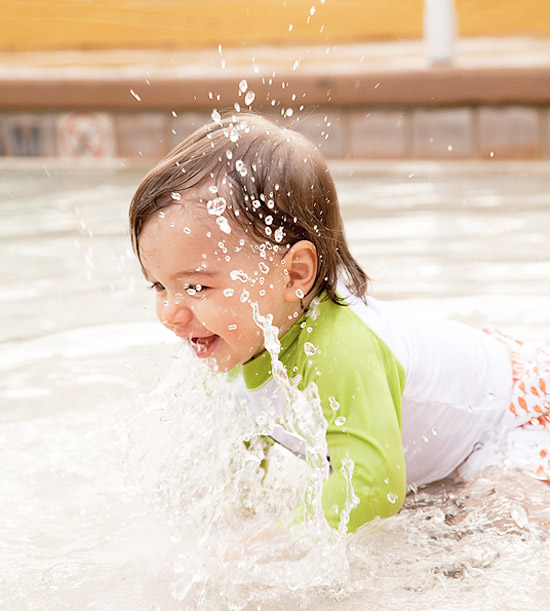
Splashing in the shallow end is divine, but mere inches of water can be dangerous. Children 12 to 36 months of age have the highest risk of drowning, according to the American Academy of Pediatrics (AAP). That said, there's plenty you can do to protect your child.
Baby swim lessons are not recommended until after your baby's first birthday, because, according to the AAP, there is currently no evidence that infant swim programs can lower their drowning risk. But you can feel free to introduce her to an outdoor swimming pool on your own if she is at least one month old. When you do, rather than rely on one of the strategies below, follow several, or all. Layering on safeguards ensures no slipups.
Water Safety Tips for Babies
Stay near. "Always be close enough to lay a hand on your child," explains Jeffrey Weiss, M.D., lead author of the AAP's latest policy statement on drowning prevention. Keep him within arm's reach when near water. Babies can drown in very little water, so be vigilant.
Beware inflatable pools. It's easy for a tot to lean over and tumble headfirst into these soft-sided water spots. Supervise carefully, empty smaller pools after use, and fence off large dunking pools.
Hit the books. Parents should have CPR and basic water-safety training, advises Connie Harvey, manager of aquatics technical development at the American Red Cross Preparedness and Health and Safety Services. Get trained through the American Heart Association or the American Red Cross.
Skip the floaties. Both the AAP and the Centers for Disease Control and Prevention (CDC) advise against air-filled swim aids. They give a false sense of security and can easily be punctured or deflate.
Fence it in. Make sure your home swimming pool is surrounded by four-sided fencing that is at least 4 feet high and a childproof gate, Dr. Weiss says.
Hold off on lessons until 12 months. The AAP does not recommend formal water safety programs for children younger than 1 year of age.
Teaching Tips for Parents
Start in the bathtub. It's an easy and convenient way to get your baby accustomed to the water. Hop in there with him to create a safe and fun environment. To get him used to the feeling of water on his head, fill a cup and gently pour it over his hair, letting it cascade over his face too.
Time it right. Even a newborn can take a dip (but make sure not to wet his face, Dr. Weiss says). You can begin introducing your baby to the water as early as you feel comfortable, as long as his belly button or circumcision has healed. The younger a child is when she starts, the more comfortable she's likely to be in the pool. Always check with your pediatrician before you start, though.
Make it fun. "Body language says it all," says Lars Merseburg, a founder of Imagine Swimming School, in New York City. If you're relaxed, smiling, and making eye contact, Baby will learn that the water is a safe, fun place to be. While you're in the water, sing songs or play games such as motorboat to keep Baby entertained.
Check the temperature. Be sure the water is more bathtime than brrr (at least 83 degrees). If the water at your pool is cooler, you can still take your baby in, but you may need to get out every 10 minutes or so to warm up. Pay attention to lip, finger, and toe color and if it turns purplish, take Baby out of the pool.
Set the mood. Stake out a calm, shallow area of the pool, and make sure Baby's rested. "If swim time interferes with his nap schedule, you can count on tears," Merseburg says.
Don't be pushy. If he looks scared, ease off. "Take Baby out, tell him it's okay, and try later," advises Cheryl Wu, M.D., a pediatrician in New York City. Some babies take to the water immediately; others are more hesitant. It's important to follow your baby's cues, and not push her to try anything she's not ready for. If your baby starts to cry or get fussy, take her out to warm up, offer her something to eat, and let her rest.
Introduce him slowly. Hold Baby securely and use a cup to wet his skin so he adjusts to the temperature. Next, ease him in gradually by dipping his feet and the rest of his body — but go no further than chin-deep.
Water Games for Babies
The four fun games below will entertain—and instruct—your bambino.
Motorboat legs
Dangle your baby's feet in the water and gently pull her around.
Benefits: She'll start kicking and get used to the feeling of water resistance.
Follow the leader
Anything from dipping her toes to dunking her nose is a blast when Baby sees you do it first.
Benefit: You'll spur your tadpole to try new things.
First stroke
Hold a rubber duckie just out of reach and coax her to grab and pull it toward her as you hold her from behind.
Benefit: It teaches stroke-like motions.
Tummy time
Lay baby on her belly on a foam mat and slowly move it back and forth.
Benefits: Strengthens back and neck and helps her feel secure while floating.
